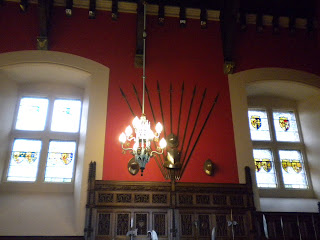So far, one particular name has come up almost daily on my travels around Edinburgh: Mary, Queen of Scots. Apart from passing references, I hadn't read much about Mary, so it's been interesting to discover more about her adventures by visiting various locations from Scottish history.
Born in 1542, Mary endured many eventful and frightening times, and it's hard not to empathise when reading accounts of her life.
Warning: if you dislike soap operas - look away! Things get intense.
[Mary aged 16, by François Clouet. Via]
As always, Wikipedia gives a concise rundown:
"Mary was the only surviving legitimate child of King James V of Scotland. She was 6 days old when her father died and she was crowned nine months later. In 1558, she married Francis, Dauphin of France. He ascended the French throne as King Francis II in 1559, and Mary became queen consort of France until she was widowed on 5 December 1560. Mary then returned to Scotland, arriving in Leith on 19 August 1561. Four years later, she married her first cousin, Henry Stuart, Lord Darnley, but their union was unhappy."
So, she married her (also young) first husband as a teenager, only to have him die two years later. Her second husband, dear cousin Henry, was a right piece of work. He was, by all accounts, jealous, paranoid, and desperate for power.
[The Jealousy of Darnley, by Giovanni Battista Cipriani.Via]
He was also dangerous, as Mary discovered when Lord Darnley and a bunch of conspirators attacked and killed her private secretary, Davide Rizzio, in her own apartments at the Holyrood Palace.
I visited the palace today, so I can confirm that the room in which they were sitting at the time is tiny (sadly no photographs permitted). It's more of an alcove really. One door. No space to escape or maneuver. It would have been terrifying to have men bursting in with guns and blades drawn. Apparently one of Henry's pals held a pistol on Mary - who was heavily pregnant at the time - while poor Davide was killed right in front of her.
[The Murder of Rizzio, by John Opie (1787). Via]
For you young folks, this is a bit like Edward killing Jacob in front of Bella - totally unacceptable. You would expect Bella to be heartbroken and then get vengeful, which is exactly what happened... Allegedly.
I'm not saying Mary was definitely a vampire. I'm just saying it's a possibility. After all, they imprisoned her for 19 years and she just wouldn't die... Beheading was required.
I digress.
After the murder, the political situation was unstable at best. Concerned for her own safety and the life of her unborn child, Mary left for Edinburgh Castle. Built as a military stronghold high atop an extinct volcano, this was the safest location she could find to give birth. It is also very close to the Holyrood Palace, so her trip wouldn't be too arduous.
...and the inside...
...Edinburgh Castle was a good choice.
As the castle is grimly strategic in design, constructed to hold off entire armies if required, the interior is likewise dedicated to war. The walls of the Great Hall are covered in spears, swords, and cutlasses.
Who knew guns could be so... decorative?
I visited Mary's old apartments there just a few days ago and got some pics of the royal chambers. There aren't many of her belongings left, but you get the sense she (and then her son) wanted these rooms to be more inviting.
In the bedroom, two large paintings of Mary and her grown son, James VI and I (eventual king of Scotland and England):
The small room in which she gave birth to baby James has a lovely painted roof, very like the ceilings in her Holyrood Palace apartments.
The light is kept very dim, but you get the idea.
The outer room features a large fireplace commemorating the union of England (the rose) and Scotland (the thistle).
The Laich Hall, created as a reception room for James, includes beautiful wood paneling, an ornate plaster ceiling and colourful murals.
No surprise that I love the fresco. From memory, it isn't the original - but still lovely.
It must have been a difficult time for Mary, giving birth to her baby in such a tempestuous political climate. Of course, Edward... er, Henry eventually got his just deserts: "In February 1567, his residence was destroyed by an explosion, and Darnley was found murdered in the garden."
[Via]
This sounds thoroughly botched to me. Wouldn't it be better to have the body consumed by the explosion, leaving no evidence of foul play? Why was he wandering about the garden? But the plot thickens, because "James Hepburn, 4th Earl of Bothwell, was generally believed to have orchestrated Darnley's death, but he was acquitted of the charge in April 1567, and the following month he married Mary."
Never enrage the mother.
[Mary, Queen of Scots in Captivity, by Nicholas Hilliard (1578). Via]
Despite the awkward timing, there wasn't much actual solid evidence of her culpability, so Mary's extended imprisonment seems very unfair today.
I think she was just doing her best, and was quite a nice vamp... er, woman.





























No comments:
Post a Comment